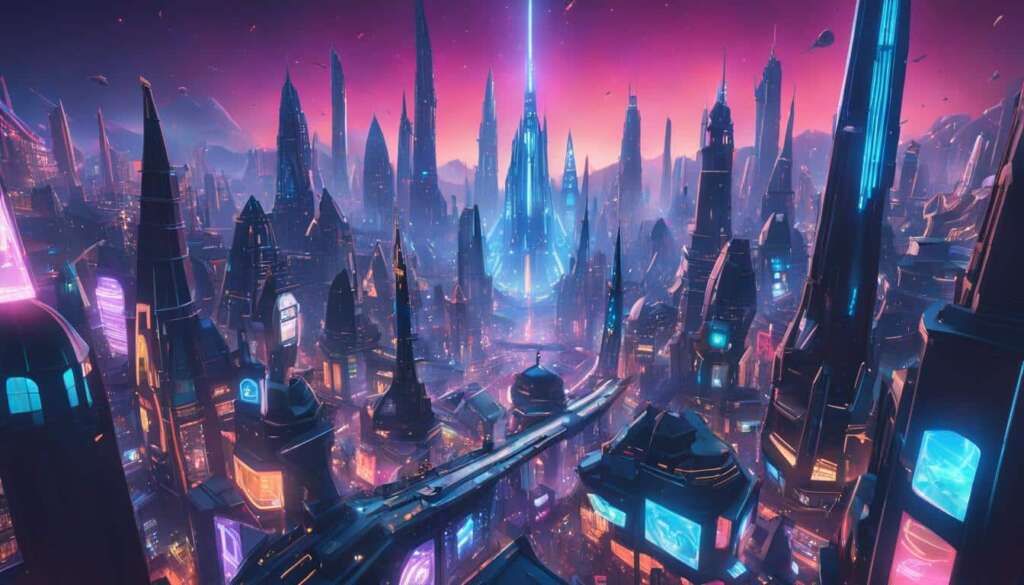Table of Contents
The meta-verse is a captivating concept that has captured the imaginations of billions worldwide. Defined as a virtual world where individuals can live, work, and connect in a 3D environment, the meta-verse is poised to redefine our digital landscape. With tech giants such as Facebook’s Meta, Google, Microsoft, Nvidia, and Qualcomm investing in this transformative idea, the meta-verse has become one of the most anticipated technological advancements of the next decade.
As the world adjusts to the idea of a virtual existence, the potential of the meta-verse economy cannot be ignored. According to McKinsey & Company, the meta-verse economy is projected to reach a staggering $5 trillion by 2030. This billion-dollar industry encompasses various enhanced online environments, ranging from virtual workplaces to immersive gaming experiences, dressing rooms, and even operating rooms. The meta-verse offers boundless opportunities for individuals, businesses, and industries.
Although the evolution of the meta-verse is still uncertain, this digital realm has the power to revolutionize how we interact, trade, and create value. Stay tuned as we delve deeper into the meta-verse, its history, workings, and the possibilities it holds for the future. Join us on this exciting journey into a world where reality and imagination merge, and the meta-verse becomes a reality.
What is the Metaverse? A Short History
The concept of the metaverse refers to a single, shared, and immersive 3D virtual space that offers unique experiences and possibilities beyond the constraints of the physical world. Coined by author Neal Stephenson in his renowned novel Snow Crash, the term “metaverse” has since captivated the imaginations of creators, technologists, and enthusiasts.
Virtual reality (VR) headsets and augmented reality (AR) glasses serve as gateways into the metaverse, enabling individuals to navigate and interact with virtual environments. These technologies have evolved rapidly, allowing users to engage with digital worlds through immersive and realistic experiences.
“Imagine being able to explore fantastical realms, socialize with people from all over the globe, attend live events, or even create and sell your own digital assets—all within a virtual space that defies the limitations of physical reality.”
While VR has seen significant advancements, other critical components to fully realize the metaverse are still under development. These components include interoperability, ensuring seamless movement between different virtual environments, and solutions that address the need for robust bandwidth to support large-scale immersive experiences.
The Immersive Potential of Snow Crash
In Neal Stephenson’s Snow Crash, published in 1992, the author envisioned a future where people could enter the metaverse and interact with each other in a virtual reality space. The novel introduced the concept of a global digital realm that transcended the physical limitations of the real world, setting the stage for the ongoing development and exploration of the metaverse.
The Evolution of the Metaverse
Since the introduction of the term by Neal Stephenson, the metaverse has continued to evolve, driven by advancements in technology and the collective efforts of innovators across various industries. Today, the metaverse represents a convergence of virtual reality, augmented reality, and other emerging technologies.
“The metaverse promises to revolutionize how we live, work, and connect by unlocking possibilities for creativity, collaboration, and experiences that surpass the boundaries of our physical existence.”
As the metaverse continues to develop, it holds immense potential for various domains, including entertainment, gaming, education, healthcare, and commerce. Businesses are exploring the metaverse as a new frontier for engaging customers, fostering community, and creating innovative digital experiences.
Comparing Virtual Reality and the Metaverse
| Features | Virtual Reality (VR) | The Metaverse |
|---|---|---|
| Immersive Experience | Yes | Yes |
| Shared Virtual Space | No | Yes |
| Persistent Digital Environment | No | Yes |
| Real-time Interactions | Yes | Yes |
| Connectivity with Physical World | Limited | Yes |
How Does the Metaverse Work?
The metaverse operates as a captivating digital ecosystem that combines cutting-edge 3D technology, real-time collaboration software, and blockchain-based decentralized finance tools. It provides users with immersive and interactive 3D environments, enabling them to explore and engage with various virtual worlds and experiences. Within the metaverse, individuals have the opportunity to own and trade digital assets, fostering a vibrant economy within this virtual realm.
One of the key components of the metaverse is its distributed network, linking different virtual spaces together. This interconnectedness allows for seamless movement and interaction between various platforms and virtual worlds. Users can traverse different environments within the metaverse without any limitations or boundaries, creating a truly interconnected digital experience.
Ownership and Governance
Open governance and decentralization are fundamental principles that underpin the metaverse. Decisions and control within this virtual realm are shared among participants, ensuring a fair and inclusive environment. This democratic approach empowers individuals to actively contribute and shape the development of the metaverse, establishing a sense of ownership and shared responsibility.
Furthermore, the metaverse aims to create a shared identity that spans across different virtual worlds and platforms. This means that users can seamlessly maintain their presence and interact with others, regardless of the specific virtual environment they are in. Whether exploring a fantasy-themed game or participating in a virtual workplace, the metaverse provides a unified experience that unites individuals from diverse backgrounds.
Realizing the Metaverse’s Potential
The metaverse has the potential to revolutionize the way we live, work, and interact in the digital realm. It offers opportunities for businesses to create innovative experiences and engage with customers in new and exciting ways. Additionally, the metaverse has the power to transform various industries, such as gaming, entertainment, education, and healthcare. It presents a multitude of possibilities for collaboration, learning, and entertainment within a dynamic and immersive virtual space.
To better understand the workings of the metaverse, let’s take a look at a visual representation:

| Key Elements of the Metaverse | Benefits |
|---|---|
| 3D Environments | Immersive and interactive experiences |
| Real-time Collaboration Software | Seamless interaction and communication |
| Blockchain-based Decentralized Finance Tools | Secure ownership and trading of digital assets |
| Distributed Network | Interconnected virtual spaces for seamless movement |
Accessing the Metaverse and its Alignment with Web 3.0
Accessing the metaverse is made possible through compatible devices and platforms, such as virtual reality (VR) headsets, augmented reality (AR) glasses, or traditional computers and smartphones. These technologies enable users to immerse themselves in virtual environments, interact with avatars, and explore a whole new digital realm.
The metaverse also aligns seamlessly with Web 3.0, the next evolution of the internet characterized by a decentralized architecture. Web 3.0 technologies, including blockchain, offer open governance, data ownership, and transparency – essential pillars for the metaverse’s operation. By integrating these advanced technologies and AI-driven applications, the metaverse aims to create an interconnected realm where users can have shared identities and exchange assets between virtual networks and the physical world.
As companies actively pursue the development and adoption of metaverse platforms, the potential for transforming businesses and our daily lives becomes more evident. The metaverse holds the promise of reshaping how we live, work, and interact in the digital age. It presents new opportunities for immersive experiences, virtual economies, and social connections, all within a decentralized and interconnected digital universe.
FAQ
What is the metaverse?
The metaverse is a virtual world where billions of people can live, work, and interact with each other in a 3D virtual environment.
Why is the metaverse gaining attention?
The metaverse has gained significant attention, especially since Facebook rebranded itself to Meta and announced plans to invest in the concept. Tech giants like Google, Microsoft, Nvidia, and Qualcomm are also investing in the metaverse. Moreover, McKinsey & Company predicts that the metaverse economy could reach trillion by 2030.
How is the term “metaverse” used?
Companies are using the term “metaverse” to refer to various types of enhanced online environments, including online video games, virtual workplaces, dressing rooms, and operating rooms.
Where did the term “metaverse” originate?
The term “metaverse” was coined in 1992 by author Neal Stephenson in his novel Snow Crash.
How do users access the metaverse?
Accessing the metaverse requires compatible devices and platforms, such as VR headsets, AR glasses, or traditional computers and smartphones.
What are the fundamental principles of the metaverse?
Open governance and decentralization are fundamental principles of the metaverse, ensuring that decisions and control are shared among participants.
What is the role of Web 3.0 in the metaverse?
The metaverse aligns with Web 3.0, the next evolution of the internet characterized by decentralized architecture. Web 3.0 technologies provide open governance, data ownership, and transparent governance, which are essential pillars of the metaverse.
The metaverse aims to create a shared identity that spans different virtual worlds and platforms, allowing for seamless movement and interaction between them.













